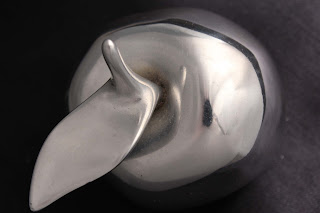Part 1 - Comparing under cloud & in sunlight
 |
2013.03.29.Church(CloudyPt.1-1)
f/22 1/60 ISO-200 |
 |
2013.03.29.Church(CloudyPt.1-2)
f/11 1/50 ISO |
The first image of the church was taken while the sun made a brief appearance into blue sky, behind the viewpoint. There are large, fairly hard shadows in the foreground. The stone of the church's exterior is warm and appears slightly yellow-orange in places. The grass, where not in shadow, is a bright and vibrant green.
The second image, with the sun now behind clouds, no longer has shadows in the foreground. The clouds act like a giant diffuser in front of the sun, now a large light source. A generally bluer appearance to the image makes it much cooler, the colours are darker and less saturated.
Although I inadvertently reduced the shutter speed slightly, clearly the f/stop had to be reduced considerably to achieve the same exposure level. While the cloud cover provides a more even light, it also reduces the light level. Obviously, I could have increased the ISO, but for the purpose of this exercise the f-stop was reduced, to demostrate the difference in light.
 |
2013.03.29.StationRdWest(CloudyPt1-1)
f/16 1/50 ISO-200 |
.jpg.jpg) |
2013.03.29.StationRdWest(CloudyPt1-2)
f/18 1/50 ISO-100 |
For the second pair of photos, I had to return on another day to take the sunny shot. As with the photos of the church, there are some hard shadows when the sun is out and the image is brighter than the one taken under cloud, although the exposure is the same.
Part 2 - Overcast
 |
2013.03.10.Cloudy Weather-Pt.2 (1)
f/9 1/40 ISO-400 |
 |
2013.03.10.Cloudy Weather-Pt.2 (2)
f/5.6 1/320 ISO-400 |
 |
2013.03.10.Cloudy Weather-Pt.2 (3)
f/5.6 1/250 ISO-200 |
In these three images taken under an overcast sky, the colours appear quite true to reality, although the temperature is low. The second image does capture the reddish-violet colour on the plant well though. The final image of this set, shows a variety of surface, with the detailed and smooths areas of the pot, the rough stone work behind, and the flat surface of the large leaf. With highlights darker than you would expect in bright sunlight, and shadows reduced, the images are low contrast.
Part 3 - Rain
.jpg.jpg) |
2013.03.17.Rain (1)
f/14 1/50 ISO-400 |
This first image taken in rain shows how it can have interesting effects on glass. The refelection is distorted in the top right corner of the frame, and the odd bit of blur is created from droplets on the window pane. The haziness from the glass steaming up adds some atmosphere.
 |
2013.03.17.Rain (2)
f/8 1/25 ISO-800 |
The rain was really falling hard when I took the second image, creating a layer of water on this table. Raindrops were falling and cause mass ripples on the layer of water. By using a slow shutter speed a quite abstract pattern was captured.
 |
2013.03.17.Rain (3)
f/14 1/15 ISO-800 |
The plastic chair in the above photograph is given texture and pattern from light effects on its wet surface. The reflection of the chair on the table is distorted. The water running over the table's surface has changed it from a diffuse reflection to direct. The angle of view and tilt in the table caused the reflection to refract and distort.
 |
2013.03.17.Rain (4)
f/6.3 1/100 ISO-800 |
In this fourth rain image, light and shadow reflect on the wet surface of the table. The light reflections distort into zig zags.
I could have chosen from a number of other shots, and was surprised at how many opportunites the rain created. Suddenly there was a lot more points of interest, just outside my back door, with surfaces and materials transformed by the wet and changes in light.



































+(1).jpg)
+(2).jpg)



.jpg.jpg)



.jpg.jpg)






